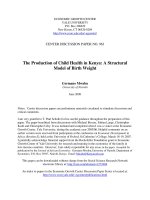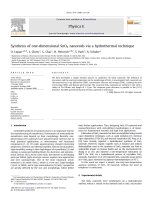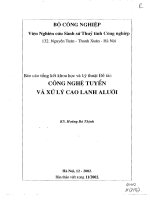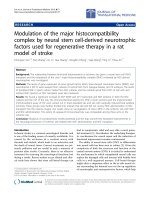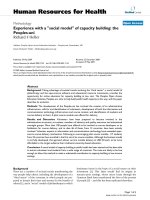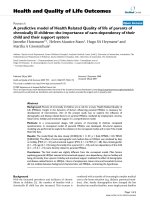- Trang chủ >>
- Khoa Học Tự Nhiên >>
- Vật lý
A structural model of one dimensional thin silica nanowires
Bạn đang xem bản rút gọn của tài liệu. Xem và tải ngay bản đầy đủ của tài liệu tại đây (362.79 KB, 4 trang )
A structural model of one-dimensional thin silica nanowires
D.J. Zhang, R.Q. Zhang
*
Department of Physics and Materials Science, City University of Hong Kong, 83 Tat Chee Avenue, Koloon, Hong Kong SAR, China
Received 27 June 2004; in final form 28 June 2004
Available online 31 July 2004
Abstract
We report a new structural model of silica molecular wire based on spiro union two-membered ring (SU-2MR) units. As revealed
by density functional calculations, the SU-2MR wire is formed by parallel 2MRs bridged by oxygen atoms and is energetically more
favorable, thermally more stable and chemically more reactive at the tip than the edge-sharing two-membered ring molecular chain
proposed early. The SU-2MR molecular chain would be considered as an appropriate structural model of one-dimensional thin
(0.4 nm) silica nanowires.
Ó 2004 Elsevier B.V. All rights reserved.
One-dimensional (1D) nanomaterials are being inten-
sively researched because of their great potentials in
mesoscopic physics and in nanod evices. Silica (SiO
2
),
which is the important component in glass, catalyst,
Si-based microelectronic derives and optical fibers, is
an increasingly important candidate to form 1D nano-
materials. Significant progresses have been made in
synthesizing silica nanowires with a variety of methods
[1–6]. Recently, very long aligned silica nan owires with
thin diameters of 5–10 nm has been synthesized by Hu
et al. [6] through thermal oxidation of silicon wafers.
Theoretical investigation of atomic structures of 1D
quantum wires is fundamentally important for under-
standing their overall properties and growth mechanism.
In contrast to the intensive study on silicon nanowires
[7,8], little has been done about silica nanowires in terms
of their geometric and electronic structures.
When forming bulk crystal, silica is a three-dimen-
sional (3D) network of corner-sharing SiO
4
tetrahedra,
frequently six-membered rings (refer to an Si–O–Si–
OÁÁÁ ring containing six Si atoms). However, the smaller
four-, three-, and two-membered rings have also been
found to exist in the surface or inter ior of amorphous
and crystalline silica, as well as vitreous silica [9–22].
In particular, two-membered rings (2MRs) exists not
only in silica-w at high temperature [15], but also in
Si–O-plasma reactions [16] as well as in the condensa-
tion of vicinal hydroxyls or the thermodynamic rear-
rangement of the pure silica structure at the surfaces
of amorphous and crystalline silica at high temperature
[17–22].
The structural diversity creates opportunities for ma-
terials with designed structures and properties. Recently,
Bromley et al. [23] proposed a structural model of silica
molecular chains based on the edge-sharing 2MR (ES-
2MR) units. They found that the chains are energetically
less stable than the corresponding molecular rings for
n >11(n is the number of SiO
2
units) [23]. Here, we pro-
pose a new model of thin silica molecular chains based
on spiro union 2MR (SU-2MR) units, aiming at provid-
ing insight into the growth of 1D silica nanowires by
searching for the preponderant structures via quantum
mechanical calculations.
The insets of Fig. 1 show representative configura-
tions of the SU-2MR molecular chains, and the ES-
2MR molecular chains and rings, respectively. To retain
the stoichiometry, the chains are terminated at either
end by non-bridging oxygen (NBO) atoms. Three other
termination modes have also been considered for the
0009-2614/$ - see front matter Ó 2004 Elsevier B.V. All rights reserved.
doi:10.1016/j.cplett.2004.07.041
*
Corresponding author. Fax: +852 2788 7830.
E-mail address: (R.Q. Zhang).
www.elsevier.com/locate/cplett
Chemical Physics Letters 394 (2004) 437–440
SU-2MR chains. However, they were found to be ener-
getically less favorable than the mode described in
Fig. 1. Note that the SU-2MR chains consist of only
even-n SiO
2
units, unlike the ES-2MR chains which con-
tain either even-n SiO
2
units or odd-n SiO
2
units. We
have performed geometric optimizations and molecular
dynamics simulations for SU-2MR molecular chains in
comparison with those of ES-2MR chains and rings,
for (SiO
2
)
n
with size varying from n = 2 to 26, using den-
sity functional theories available in both SIESTA 1.3
[24–26] and G
AUSSIANAUSSIAN
98 [27] codes. The SIESTA geo-
metric optimizations were first performed using the Per-
dew–Burke–ErnzerhofÕs [28] Generalized Gradient
Approximation (GGA) functional with the double-f
plus polarization orbital (DZP). And further Gaussian
calculations wer e carried out at the B3LYP/6-31G(d)
level of theory, which has been confirmed to be enough
accurate for describing silica systems [29].
The geometries of the two kinds of the silica chains
show their respective unique characteristics. Firstly,
the shapes and mutual positions of basic 2MR rings
are different. In ES-2MR chains, all of the Si atoms form
a line with the planar 2MRs perpendicular to each
other. Whereas, in SU-2MR chains, the Si atoms divide
into two parallel arrays linked by the bridging oxygen
(BO) atoms. Secondly, the SU-2MR chain is more com-
pact than the ES-2MR chain. The former possesses
much larger radial size ($0.4 nm) and thus is relatively
shorter than the latter at the same size. Thirdly, we
found that the SU-2MR chains tend to be slightly
curved as n > 20 due to the poorer symmetry, while long
ES-2MR chains still keep their straight line.
To evaluate the energetic stability of these chains, we
calculated their binding energies (BEs) per SiO
2
unit as
shown in Fig. 1, which is defined as the energy necessa ry
to dissociate the cluster into SiO
2
monomers. Note that
this energy index is equivalent to the strain energy rela-
tive to a-silica used in our previous work [30]. Compar-
ison with the ES-2MR chains [curve (b)], our SU-2M R
chains are energetically less favorable for smaller sizes
(n < 9). For example, the BE of the SU-2MR chain at
n = 6 is smaller than the corresponding ES-2MR chain
by 0.20 eV/SiO
2
. The larger stability for these small
ES-2MR chains is related to their smaller fraction of
NBOs. However, this factor would become less impor-
tant with the increase of chain length. Instead, the in-
trinsic internal strain on 2MRs for larger chains
remain a crucial factor in stabilizing (SiO
2
)
n
chains.
SU-2MR chains are more rapidly stabilized with in-
creasing n, due to both its relative ly small number of
2MRs and the attendance of BO atoms. As shown in
Fig. 1, the energetic stability of the SU-2MR chains ex-
ceeds those of ES-2MR chains and also rings as n >8.It
is indicated that ES-2MR chains would be more favora-
ble in the initial stage of the silica nanoparticle embryo.
However, longer silica nanowires prefer SU-2MR struc-
tures. A growth mode change from the ES-2MR chain
could be expected at n $ 9 with growth direction change
and an open up of the end 2MR to facilitate the fol-
lowed SU-2MR growth.
To further test the structural stability of these molec-
ular chains, we performed density functional molecular
dynamics simulations using SIESTA for chains with dif-
ferent sizes at several temperatures, i.e., 500, 1000, 1500,
2000 and 3000 K. The simulation time step was chosen
to be 1 fs, and the relaxed steps was set to 1000. Atomic
forces are calculated using the Hellmann–Feymann the-
Fig. 2. HOMO–LUMO gaps of the silica molecular chains as a
function of n for (a) SU-2MR chains, and (b) ES-2MR chains. The
insets show the isodensity surfaces of the HOMO and LUMO of the
SU-2MR chain at n = 12.
Fig. 1. Binding energy per SiO
2
unit as a function of the silica cluster
size for (a) the SU-2MR chains, (b) the ES-2MR chains, and (c) the
ES-2MR rings. The insets show the geometries of the representative
clusters.
438 D.J. Zhang, R.Q. Zhang / Chemical Physics Letters 394 (2004) 437–440
orem; NewtonÕs equations are integrated by means of
VerletÕs algorithm. We found that all these chains retain
their initial connectivity throughout the whol e simula-
tions even at 3000 K which is far higher than the synthe-
sis conditions envisaged ($1000 K). It is indica ted that
both ES-2MR and SU-2MR chains are extremely ther-
mally stable, and very resistant to collapse or rupture.
Moreover, the thermal stability of these chains is not
sensitive to the cluster size, confirming their intrinsically
structural rationality.
To examine their electronic properties and the reac-
tivity, we calculated the energy gaps between the highest
occupied molecular orbitals (HOMOs) and the lowest
unoccupied molecular orbitals (LUMOs) of these mo-
lecular chains. As shown in Fig. 2, the gaps for the
two kinds of molecular chains rapidly level off to a con-
stant, 6.45 eV for ES-2MR chains as n > 14, and 5.91 eV
for SU-2MR chains as n > 18. Both the HOMOs and
LUMOs of these chains highly localize at the ends of
the chains, making mainly these regions responsible
for their energy gaps. As an example, the insets of
Fig. 2 show the isodensity surfaces of the HOMO and
LUMO states of the SU-2MR chain at n = 12, respec-
tively. The energy gap is a signature of the chemical re-
activity of a system. Compared to the ES-2MR chains,
the relatively smaller gaps of SU-2MR chains indicate
higher chemical reactivities, facilitating the continuous
growth of the chains. Hence, the SU-2MR chain may
be a more reasonable growth mod el of 1D silica nano-
wires. Fig. 3 schematically illustrates the growth mecha-
nisms [monomer mode (a) and dimer mode (b)] of the
silica nanowires according to the present SU-2MR
model, in which the most stable linear monomer and
rhomb dimer are regarded as preferential growth precur-
sors, respectively.
The relative reactivity of these chains is also borne
out by their ionization potentials (IP). We calculated
their vertical IPs for several representative structures.
For example, the vertical IP of the ES-2MR chain at
n = 12 is 14.82 eV, and that for the SU-2MR chain at
n = 18 is 9.79 eV. The high ionization potential facili-
tates their separation as neutral species from other silica
clusters in an ionizing environment [31].
In conclusion, we presented a new SU-2MR model of
silica molecular chains. It is proposed to be a more ap-
propriate growth model of 1D silica nanowires because
of their higher energetic and thermal stabilities and
chemical reactivity than those of ES-2MR chains pro-
posed early by Bromley et al., as n >8.
Acknowledgements
The work described in this Letter was supported by
two grants from the Research Grants Council of the
Hong Kong Special Administrative Region, China [pro-
ject No. CityU 1011/01P; and project No. CityU 1033/
00P].
Fig. 3. Schematic illustrations of the silica nanowire growth in (a) a monomer growth mode, and (b) a dimer growth mode.
D.J. Zhang, R.Q. Zhang / Chemical Physics Letters 394 (2004) 437–440 439
References
[1] D.P. Yu, Q.L. Hang, Y. Ding, H.Z. Zhang, Z.G. Bai, J.J. Wang,
Y.H. Zou, Appl. Phys. Lett. 73 (1998) 3076.
[2] H. Takikawa, M. Yatsuki, T. Sakakibara, Jpn. J. Appl. Phys. 38
(1999) L401.
[3] X.C. Wu, W.H. Song, K.Y. Wang, T. Hu, B. Zhao, Y.P. Sun,
J.J. Du, Chem. Phys. Lett. 336 (2001) 53.
[4] Z.Q. Liu, S.S. Xie, L.F. Sun, D.S. Tang, W.Y. Zhou, C.Y. Wang,
W. Liu, Y.B. Li, X.P. Zou, G. Wang, J. Mater. Res. 16 (2001)
683.
[5] W.B. Hu, Y.Q. Zhu, W.G. Xu, Sci. China Ser. B 45 (2002) 389.
[6] J.Q. Hu, Y. Jiang, X.M. Meng, C.S. Lee, S.T. Lee, Chem. Phys.
Lett. 367 (2003) 339.
[7] M. Menon, E. Richter, Phys. Rev. Lett. 83 (1999) 792.
[8] B.X. Li, P.L. Cao, R.Q. Zhang, S.T. Lee, Phys. Rev. B 65 (2003)
125305.
[9] R.H. Stolen, J.T. Krause, C.R. Kurkjian, Discuss. Faraday Soc.
50 (1970) 103.
[10] F.L. Galeener, G. Lucovsky, Phys. Rev. Lett. 37 (1976) 1474.
[11] F.L. Galeener, Solid State Commun. 44 (1982) 1037.
[12] A. Pasquarello, R. Car, Phys. Rev. Lett. 80 (1998) 5145.
[13] H. Hosono, Y. Ikuta, T. Kinoshita, K. Kajihara, M. Hirano,
Phys. Rev. Lett. 87 (2001) 175501.
[14] P. Umari, X. Gonze, A. Pasquarello, Phys. Rev. Lett. 90 (2003)
027401.
[15] A. Weiss, Z. Anorg. Allg. Chem. 276 (1954) 95.
[16] L.S. Wang, J.B. Nicholas, M. Dupuis, H. Wu, S.S. Colson, Phys.
Rev. Lett. 78 (1997) 4450.
[17] C.M. Chiang, B.R. Zegarski, L.H. Dubois, J. Phys. Chem. 97
(1993) 6948.
[18] A.M. Ferrari, E. Garrone, G. Spoto, P. Ugliengo, A. Zecchina,
Surf. Sci. 323 (1995) 151.
[19] V.A. Bakaev, W.A. Steele, J. Chem. Phys. 111 (1999) 9803.
[20] D. Ceresoli, M. Bernasconi, S. Iarlori, M. Parrinello, E. Tosatti,
Phys. Rev. Lett. 84 (2000) 3887.
[21] A. Roder, W. Kob, K. Binder, J. Chem. Phys. 114 (2001) 7602.
[22] M. Benoit, S. Ispas, M.E. Tuckerman, Phys. Rev. B 64 (2001)
224205.
[23] S.T. Bromley, M.A. Zwijnenburg, Th. Maschmeyer, Phys. Rev.
Lett. 90 (2003) 035502.
[24] P. Ordejo
´
n, E. Artacho, J.M. Soler, Phys. Rev. B 53 (1996)
R10441.
[25] D. Sa
´
nchez-Portal, P. Ordejo
´
n, E. Artacho, J.M. Soler, Int. J.
Quantum Chem. 65 (1997) 453.
[26] J.M. Soler, E. Artacho, J.D. Gale, A. Garcı
´
a, J. Junquera, P.
Ordejo
´
n, D. Sa
´
nchez-Portal, J. Phys.: Condens. Matter 14 (2002)
2745 and references therein.
[27] M.J. Frish et al., G
AUSSIANAUSSIAN
98, Gaussian, Inc., Pittsburgh, PA,
1998.
[28] J.P. Perdew, K. Burke, M. Ernzerhof, Phys. Rev. Lett. 77 (1996)
3865.
[29] T.S. Chu, R.Q. Zhang, H.F. Cheug, J. Phys. Chem. B 105 (2001)
1705.
[30] M.W. Zhao, R.Q. Zhang, S.T. Lee, Phys. Rev. B 69 (2004)
153403.
[31] S.T. Bromley, M.A. Zwijnenburg, E. Flikkema, Th. Maschmeyer,
Phys. Rev. Lett. 92 (2004) 039602.
440 D.J. Zhang, R.Q. Zhang / Chemical Physics Letters 394 (2004) 437–440
